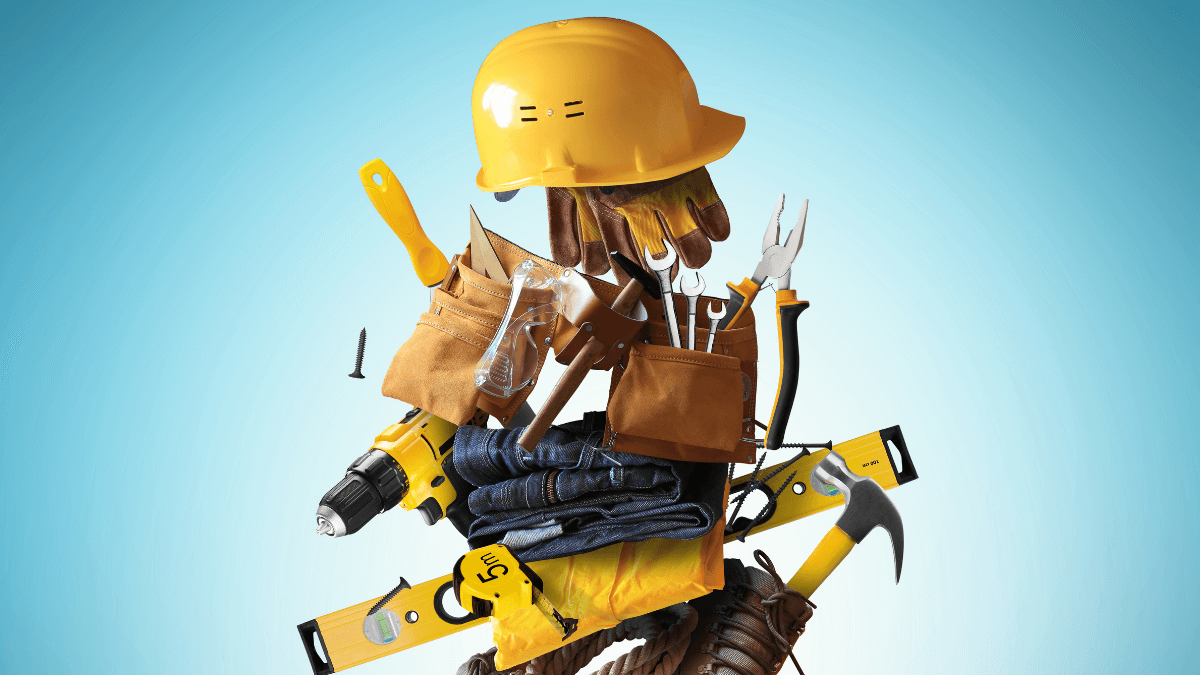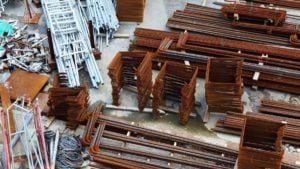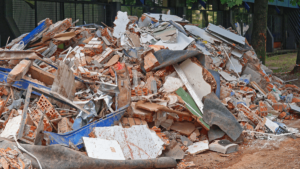Despite modernization, construction sites continue to use some old-fashioned hand tools, which have proven to be durable, easy to use, and effective.
Also, manual work is often neater and more precise than the same work done by powered machines or bigger equipment.
We bring you a list of 16 essential, practical tools that are used in almost every construction worksite.
With proper training, anyone can use the tools mentioned in this article safely.
To ensure that they are in good condition and safe to use, we also share some tips on equipment maintenance and management.
In this article...
Hand Drill
Construction sites around the world use hand drills in their day-to-day operations.
The primary purpose of those tools is to drill holes in many types of materials, but they are also used to bind two materials or objects together. This makes them a helpful construction site tool.
As they reduce manual labor, and are cheap and easy to use, hand drills can be seen in many worksites.
The most common types of drills are:
- Hammer drill: suitable for materials other than concrete
- SDS drill: designed for drilling concrete
- Cordless drill: most commonly used for screw driving; you can use it on wood but not on concrete.
It’s essential to keep the drill clean and in a secure place when it’s not in use.
When a tool is not maintained correctly, it can become dull and jam or the air vents can get clogged. All of this can cause accidents.
A check before and after using the tool will help you understand what state it is in, and whether you need to replace it.
Read more about the dangers of poor tool control here.
Portable Concrete Mixer
A concrete mixer helps the workers by providing fresh concrete at the worksite without the wait.
It’s a low-cost, time-saving tool that many worksites use to maximize efficiency. All that’s necessary are cement, water, and an aggregate (gravel or sand).
Workers can produce a new batch and time it based on their needs.
The workers must understand how much concrete they need since they will need to mix it themselves.
They should make 10% more concrete than necessary. That way, they avoid having to stop in the middle of the project to make some more, as the already poured concrete is left to dry.
The places where pouring concrete stops and continues with a new batch are called cold joints, and they indicate places where the concrete is more likely to break later.
If you manage a team of construction workers, encourage them to use assets wisely and avoid such poor outcomes by instructing them to think ahead.
They should always make sure they have material to spare.
Workers should use protective gear when handling a portable concrete mixer to avoid any injuries related to concrete splatters.
Nail Gun
Nail guns help drive nails through wood and other types of material used in construction, performing the task a lot quicker than a worker with a nail and hammer.
Their most common use is in housing construction since they increase efficiency and are relatively easy to use.
Workers need to be familiar with the trigger mechanism of the tool to know how to use it and avoid injuries.
There are different mechanisms that vary according to the sequence of activating the safety tip on the nose of the tool and the finger trigger. They also differ depending on whether the worker must keep the finger trigger squeezed to discharge multiple nails or not.
Based on these options, four types of mechanisms exist:
- the full sequential trigger
- contact trigger
- single sequential trigger
- single actuation trigger
The full sequential trigger is the safest option since its mechanism makes it almost impossible to fire a nail by accident.
Keep in mind that nail guns cause around 37,000 injuries a year, most of them on the hand or fingers.
Therefore, provide workers with hands-on training, explain the trigger mechanisms, and give them proper equipment.
It is vital that they use safety goggles, hard hats, and earplugs to avoid workplace accidents.
Screed
Screeds or bump cutters are flat tools used to straighten the surface of the concrete to make sure there are no bumps or texture irregularities. This step is done immediately after pouring and spreading the concrete to mold it before it hardens.
You can screed with both hand and mechanical tools, which differ in size.
Hand tools consist of a large, straight piece of wood or a hollow aluminum or metal straightedge. They need to be dragged across the surface carefully to make sure the excess concrete is straightened.
Usually, two or more people do hand screeding to guarantee that the tool is in a straight position.
On bigger construction sites, mechanical tools such as vibrating and laser screeds help workers make sure the concrete surface is straight.
They boost productivity up to 50% and require less manual labor since they cover a larger surface area and are easy to operate.
Screeding is not the finishing step—it’s followed by floating, which helps make sure the surface is as smooth as necessary.
Floats
Construction workers use floats to ensure there are no ridges, holes, or indents left after screeding.
Floating—the process of gliding over the surface with a float to smooth it out—lets the water come out of the concrete because it doesn’t close it, which makes it integral in this part of the construction process.
Floats designed for concrete are usually made out of wood, aluminum, or magnesium, and they can vary in size.
The most popular float material among professionals is magnesium since it slides over the surface without closing it or dragging the concrete along.
The bull float is a bigger tool that you need to push around using a long handle. Its advantage is that it covers the area quickly.
For smaller areas that a bull float can’t reach, workers usually use a darby or a hand float, a typical round or square-edged hand tool.
Hand floats are good at getting to the corners, around obstacles such as drains and pipes, and fixing overlay marks.
Masonry Trowel
There are different types of masonry trowels based on their purpose, and the most common ones are the brick trowel and the concrete finishing one. They all vary in size and material.
Brick or mason’s trowels are pointy-nosed tools used to spread mortar over bricks or blocks to keep them in place.
An amount of mortar is picked up with the tool’s nose and then spread over the side of the brick that will come in contact with another brick, helping them stay in place and stick to each other.
You should use concrete finishing trowels after floating the concrete and once the water has evaporated.
When used before, you risk trapping water under the surface, leading to materials fracturing into layers.
After you flatten the surface, use the trowels to harden the concrete.
During the first try, avoid pressing the blade on the concrete too much because this will cause instant hardening.
As the concrete dries, you need to do additional troweling using a smaller trowel that helps add pressure to the wet concrete.
Wheelbarrow
Wheelbarrows can be seen at the worksite whenever there is a need to carry around construction materials, supplies, or tools.
The first confirmed use of the wheelbarrow dates back to 118 AD, and it is clear why this tool is just as useful now as it was back then.
Instead of carrying the material in their hands and having to take multiple trips, workers can put all the materials inside the wheelbarrow and wheel it around the worksite.
The design with two handles helps one person use it with ease, and the wheel helps move materials around the construction site.
There are many different types of wheelbarrows, varying in handle material, bucket material, tire type, and the number of wheels.
The benefits of using a wheelbarrow include no pollution to the environment, carrying more load than a single person could carry in their hands, and accessing areas that vehicles cannot access.
They are straightforward to use and are cost-effective, which results in them being so popular.
Putty Knife
This versatile tool can serve several purposes, from applying compounds to getting rid of residue material, making it useful in construction.
Its flatness allows smoothing the surface and scraping remains off without causing damage.
The putty knife is often called a spatula or a scraper, precisely because it works perfectly to eliminate the unwanted surplus of material.
Putty knives differ in various elements:
- edges
- edge angles
- stiffness of the blade
- blade material
- width
The flexible putty knife is better for applying filler material, while the stiff one has more use in removing material or scraping it off.
The metal putty knife used to be the most common type, but nowadays, the plastic types seem to be more popular, despite being less sturdy and resilient.
However, the stainless steel putty knife is recommended for construction since it’s less likely to erode. As a result, it is more likely to last longer.
Ladder
Ladders are commonly used in construction due to their cost-effectiveness and ease of use.
They can be carried around, which comes in handy at the worksite, and set up in a matter of minutes by one or two workers due to their design.
Other than the commonly used step and extension ladder, the multi-purpose ladder and articulated ladder are widespread as well.
However, ladders have to be used properly to avoid accidents and falls.
The most important thing to note when using a ladder is to maintain three-point contact at all times—two hands and one foot, or two feet and one hand.
Workers should check if they’ve set up the ladder correctly before climbing up and make sure the ladder is in good condition.
In case of any signs of damage, the worker should avoid using the ladder before further inspection.
If you want all of your workers to perform checks before and after using such tools and for their feedback to be readily available to you, consider using check-in and check-out software to simplify the process.
Measuring Tape
A crucial part of construction is ensuring all your measurements are correct, and a measuring tape helps with that.
Every step of the construction process requires measuring.
Correct measurements are vital for a successful project, since any mistakes can lead to poor results and dissatisfaction.
The tape measure is the most widely used method of measuring, since it is compact and durable.
You can carry tape measures with you wherever you go, so they are always at hand and ready to use. Using them requires no prior setup.
They often come in bright colors and with big lettering, so the measures are easy to read even when the lighting is not optimal.
The length of the tape, its covering material, the case fabric, and the tape’s standout—the distance the tool can cover while remaining straight—should be taken into account when selecting the right type.
Some prefer options with a magnetic tip ending that sticks to the metal surface.
This allows the worker to move backward, safe in the knowledge that tape is in place, and that the final measurement is correct.
Line Levels
Line level is a tool that helps you understand whether your line is straight or not, which can pertain to many aspects of construction, such as floor, tiles, windows, and doors.
If you don’t level a building properly, there will always be more pressure on one side than the other, which will affect the structure negatively and require expensive repairs.
The most common types are the spirit line level and the laser line level, with the latter primarily used in construction.
The spirit line level is quite a simple tool, which is why it’s been popular for a long time, dating back to the 17th century.
The small tool contains a vial filled with liquid which shifts to the left or right if the line is not straight. The instrument was dubbed spirit level because the liquid inside used to be alcohol.
Construction sites mainly use the laser line level. It’s more precise than the standard line level because it can project straight lines across multiple planes, easing the process for workers.
Crowbar
A crowbar or pry bar is a long metal bar with one curved end split slightly in the middle and another flattened one, making it the perfect tool for pulling objects apart with ease.
Crowbars are made from carbon steel or titanium to handle the pressure of use. The titanium ones are lighter and not magnetic, which can be important for specific worksites.
These tools are used to pull nails away from the material using the curved tip and provide enhanced pressure when pulling larger objects, such as floor tiling, apart.
Crowbars serve as first-class levers, meaning that a more significant force can be applied to pry objects away.
They can also be helpful in demolition when you need to break bigger objects into pieces.
The different varieties include the wrecking bar used for wedging and nail pulling, the sleeve bar best suited for upholstery work, and the molding bar that helps remove nails without damaging the object around it.
Sledgehammer
The usual sledgehammers consist of a wooden or plastic handle and metal head bigger than the regular hammer’s, making it one of the best hand tools for demolition.
This tool has many purposes other than demolition, such as smashing rock and concrete, pushing wooden walls into place, and driving a stake through a wall to keep it in place.
As opposed to regular hammers, a sledgehammer needs to be used with two hands not just to provide greater force but because it is a bit sturdier.
Due to the type of work you use this tool for, it is necessary to check its state often to understand whether it is still safe.
If you miss the target and hit with the handle instead, the impact can damage the handle over time.
Workers using sledgehammers should always wear safety goggles as objects can break into pieces and fly around, making this type of work dangerous.
The worker should also wear protective clothing, a helmet, and gloves to ensure safety.
Screwdrivers
Screwdrivers can be found everywhere nowadays, including construction sites, where they are always necessary.
Although screwdrivers can be powered, the most common types are not. Instead, they are simple, durable hand tools that are easy to use by one person.
These tools fit into bags and pockets and can easily be carried around the worksite, and even taken off site.
Since small tools like screwdrivers are easily lost or misplaced, you should keep them well-organized in your tool crib or label them and manage their use and location with a tool tracking app.
Workers utilize screwdrivers to put a screw into place, tighten it, or remove it.
Screws are removed by sticking the tip of the steel or metal bar into the screw, holding the plastic, wooden, or metal handle, and then twisting it in the clockwise direction to install the screw and in the opposite to unscrew it.
If the tip is damaged, you should replace the screwdriver as it could disfigure the head of the screw.
Compared to a simply reactive approach, proactive maintenance is less costly and more efficient, which is why it’s essential to inspect the equipment before and after use to ensure it’s in perfect condition.
Pliers
Compactness and the fact that they enhance the user’s strength makes pliers are a popular construction site hand tool.
Pliers consist of two opposing metal levers that form long handles and a shorter tip.
This design helps amplify the force used to squeeze the handles, allowing the user to perform specific tasks otherwise almost impossible to do by hand.
Pliers are typically used for bending, gripping, pulling, or cutting different materials.
The all-purpose pliers, which combine the wire-cutting aspect of diagonal pliers with the length of long-nose ones, will be helpful in many cases.
However, in certain situations you may find that other types serve your purpose better.
For instance, combination pliers are a must-have if you do electrical work, since they work best with wires, whether it’s pulling, cutting, bending, or straightening.
On the other hand, long-nose pliers are similar to combination pliers in their purpose, but they are elongated to reach tight, small places.
Finally, diagonal-cutting pliers help cut different types of wires, nails, and screws (up to 5 mm).
Wrenches
The purpose of a wrench or spanner is to tighten or untighten a screw or bolt by turning it to the side.
The head of the wrench’s design lets it wrap around the fastener. The other end of the tool, the box end, is placed over the bolt or screw.
Wrenches vary in size since they need to have the perfect grip on the screw you want to tighten.
Therefore, you can opt for a whole set of spanners to make sure you always have the right size, or you can invest in an adjustable wrench which can, as the name suggests, adjust to the size of the item you are trying to tighten. The adjustment is possible due to its moveable head.
The types of wrenches are:
- the open-end spanner with two open ends that usually differ in size
- a combination wrench with an open and a box end
- a ratchet wrench whose mechanism allows you to move the tool back and forth without having to adjust your grip or remove the spanner to adjust it again
Wrenches of all sizes are indispensable in construction.
Conclusion
The essential tools found on any construction site differ in size, material, and use. However, the one thing they have in common is that they can serve their purpose for a long time.
All you have to do is invest in them.
Even the most essential tools such as the screwdriver, measuring tape, and ladders need proper maintenance and frequent checks.
It is easy to lose or misplace smaller tools, so you should invest in software that helps you track not only the equipment itself but also its condition.
Tools like GoCodes Asset Tracking help you track the tool’s location and current state, allowing users to report on the state of the equipment before returning it.









